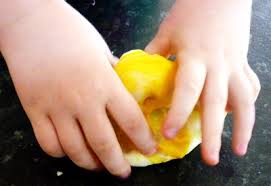a featured technique by Paris Goodyear-Brown
 We are looking forward to having Paris Goodyear-Brown come to Salt Lake City and present at our Bi-Annual Conference in September. We recently went to her website and found a section called: “Featured Technique.” She shares The “Good-At” Game. This technique can be used for individual, group, or family therapy. It can be used with children as young as three-years-old. Paris indicates that this intervention can be used at the beginning, working, or termination phase of treatment. All you need is a can of Playdoh for the client or clients and “treasures” (glass stones, coins, and colored trinkets for decoration).
We are looking forward to having Paris Goodyear-Brown come to Salt Lake City and present at our Bi-Annual Conference in September. We recently went to her website and found a section called: “Featured Technique.” She shares The “Good-At” Game. This technique can be used for individual, group, or family therapy. It can be used with children as young as three-years-old. Paris indicates that this intervention can be used at the beginning, working, or termination phase of treatment. All you need is a can of Playdoh for the client or clients and “treasures” (glass stones, coins, and colored trinkets for decoration).
These are her instructions:
“Open a can of Playdoh for each participant. Begin by instructing the client to take one little chunk of Playdoh and put it to the side. Roll the rest into a ball. Then press both thumbs into the middle (to begin to hollow out a center) and mold it into a shape that looks like a cup or a nest. Then take the leftover Playdoh (that which was put aside) and place it in front of the client. Instruct the client to roll it into a ball and then flatten it into the shape of a pancake. Invite the client to create facial features for the flat circle of PlayDoh using stones, coins, etc. from the treasure chest. When the face is finished, have the client fill up the rest of the PlayDoh (shaped like a cup or nest) with treasures. Put the lid/face on top of the cupped piece, covering up the treasures. The client has now created a rough Playdoh person. The therapist points out that the Playdoh person doesn’t look very interesting from the outside. Since you can’t tell a lot about this person from the outside, she has to be opened up. She has to tell us about all the things that make her special. Model pulling out one treasure at a time from the PlayDoh person’s body while making a statement that begins with “I am good at…”. The therapist should model statements like “I am good at laughing”, “I am good at dressing myself”, “I am good at listening.” It is important that client begin to realize that skills and abilities that she may take for granted are part of what makes her unique and special. The child then has a turn to make a “Good-At” statement for each of the treasures in his/her Playdoh person.”
Paris provides great insights and techniques to help young clients. The above intervention can help clients notice the things they are good at. Paris suggests we can assign our young clients to ask three different safe adults to tell them what they are good at. They will report their findings in the next session. She suggests that that if children’s self-esteem is too low, the therapist will need to help children notice their strengths and talents.
For more details about this intervention, please visit Paris’ website at: http://www.parisandme.com
